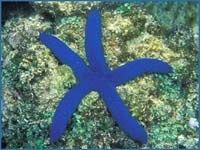Blue Sea Star

Common Name: Blue Starfish
Scientific Name: Linckia Laevigata
Description
The Blue Sea Star has 5 cylindrical arms with rounded tips and an eye at each end. The eyes see only light and darkness. The mouth is found in the centre of the body on the underside. Animals less than 5 cm wide are blue-green with dark spots. As they mature they most commonly acquire a bright blue colour, although there are colour variants throughout the Indo-Pacific ranging from bright blue to green, pink or yellow. Juveniles have pale yellow tube feet and adults have dark yellow feet. Maximum size is approximately 30cm.
Diet
When sea stars eat, they sit on top of the food and push their stomach out through their mouth to cover the food and digest it externally. The Blue Sea Star is an omonivore (eats both plants and animals). It is predominantly a scavenger, living on dead organisms within the coral reef and on rocks, but also feeds on algae and microbes.
Behaviour
Sea stars move very slowly using their water filled tubes and tube feet that stick out through the skin to hold onto surfaces. They use a water-vascular system that works on water pressure, creating a network of tube feet that look like hundreds of tiny, hydraulically operated legs.
Habitat
Commonly found on coral reef flats, rocky reefs and other shallow areas, especially in areas with wave action.
Life History
Blue Sea Stars have separate sexes (male and female). To reproduce, they release large numbers of eggs into the water. Sea stars are restricted to their home reef as adults, but are able to disperse as larvae.
Special Features or Habits
A special feature about sea stars is that they can regenerate their arms if damaged or lost, growing back into a full sea star (although they are fragile and often do not survive a lot of damage to their limbs). The Blue Sea Star frequently plays host to a tiny shrimp and sometimes a small gastropod snail that are identical in colour to the sea star. The shrimp or snail live in the grooves on the underside of the arms.
Location or Region Found
They are found throughout the Indo-Pacific region from eastern Africa (absent from the Red Sea) to Hawaii, the South Pacific Islands, Australia, Thailand, and Japan.
 Deep Sea Crabs
Deep Sea Crabs